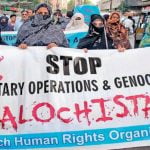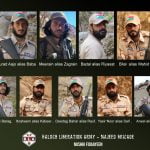This chapter aims to describe the Baloch as an ethnic group in the Persian Gulf region, and particularly to discuss issues of ethnic, linguistic, and cultural identity. Balochistan and the Baloch1 have during the past few decades attracted international attention in the shadow of political crises in Afghanistan, such as the Soviet invasion in 1979 and the US ouster of the Taliban government in 2001. Balochistan, the land of the Baloch, is a region with disputed borders situated in southeastern Iran, southwestern Pakistan, and southern Afghanistan. On present-day political maps, Balochistan constitutes the largest province (by area) of Pakistan. In Iran, the province of which Balochistan is a part is also the largest province. It comprises the northern area of Sistan as well and carries the official name Sistan and Balochistan Province.
Keywords
Indian Ocean Arabian Peninsula Slave Trade Fars Province Free Trade Zone
Notes
-
2.Brian Spooner, “Baluchistan, i: Geography, History, and Ethnography,” in Encyclopedia Iranica III (1989), 599.Google Scholar
-
4.Abdolhossein Yadegari, “Pluralism and Change in Iranian Balochistan,” in Carina Jahani, Agnes Korn, and Paul Titus, eds., The Baloch and Others: Linguistic, Historical and Socio-Political Perspectives on Pluralism in Balochistan (Wiesbaden: Reichert, 2008), 250.Google Scholar
-
5.See, for example, Brian Spooner, “The Baloch in Islamic Civilization, Western Ethnography, and World History,” Journal of the Middle East and Africa 4 (2013): 143CrossRefGoogle Scholar
-
Mohammad Hassan Hosseinbor, Iran and its Nationalities: the Case of Baluch Nationalism (Karachi: Pakistani Adab Publications, 2000), 61Google Scholar
-
Adam Nader Baranzehi, “The Sarawani Dialect of Balochi and Persian Influence on It,” in Carina Jahani and Agnes Korn, eds., The Baloch and Their Neighbours: Ethnic and Linguistic Contact in Balochistan in Historical and Modern Times (Wiesbaden: Reichert, 2003), 79Google Scholar
-
8.Including Spooner, “Baluchistan,” 599; Hosseinbor, Iran and Its Nationalities, 55–56; and Ugo Fabietti, “Equality versus Hierarchy: Conceptualizing Change in Southern Balochistan,” in Paul Titus, ed., Marginality and Modernity: Ethnicity and change in Post-Colonial Balochistan (Oxford: Oxford University Press, 1996), 5, who also mentions a “shared system of values” as a uniting factor, the “Balochi honour code” (Bal. balōčmayār).Google Scholar
-
9.The Jadgals/Brahuis are bilingual in Jadgali/Brahui and Balochi (or even trilingual adding the national language as well). See, for example, Behrooz Barjasteh Delforooz, “A Sociolinguistic Survey among the Jadgal in Iranian Balochistan,” in Jahani et al., The Baloch and Others, 23–43; Yadegari, “Pluralism and Change in Iranian Balochistan,” 249–50; Taj Mohammad Breseeg, Baloch Nationalism: Its Origin and Development (Karachi: Karachi Royal Book Co., 2004), 126–31Google Scholar
-
Carina Jahani, “The Balochi Language and Languages in Iranian Balochistan,” Journal of the Middle East and Africa 4 (2013): 163–64.CrossRefGoogle Scholar
-
11.Selig S. Harrison, In Afghanistan’s Shadow: Baluch Nationalism and Soviet Temptations (New York: Carnegie Endowment for International Peace, 1981), 177–78, also discusses the dilemma of establishing trustworthy population statistics for the Baloch.Google Scholar
-
21.Just Boedeker, “Baloch Identities: A Matter of Descent or Mentality?,” Journal of the Middle East and Africa 4 (2013): 233–34.CrossRefGoogle Scholar
-
26.For a Balochi dialect map, see Carina Jahani and Agnes Korn, “Balochi,” in Gernot Windfuhr, ed., The Iranian Languages (London and New York: Routledge, 2009), 638.Google Scholar
-
27.See Carina Jahani, “State Control and its Impact on Language in Balochistan,” in Annika Rabo and Bo Utas, eds., The Role of the State in West Asia (Stockholm: Swedish Research Institute in Istanbul, 2005), 158–60.Google Scholar
-
29.Tim Farrell, Basic Balochi (Naples: Istituto Universitario Orientale, 1990), as well as several articles by the same author describing Karachi BalochiGoogle Scholar
-
Nigel A. Collett, A Grammar, Phrase Book and Vocabulary of Baluchi (as Spoken in the Sultanate of Oman), 2nd ed. (Abingdon, UK: Burgess & Son, 1986). There is also new linguistic research being carried out on the Makran coast in Iran by Maryam Nourzaei (Uppsala University) and Agnes Korn (Frankfurt am Main University), which is awaiting publication.Google Scholar
-
37.Josef Elfenbein, “Baluchistan iii: Baluchi Language and Literature,” in Encyclopedia Iranica III (1989), 640.Google Scholar
-
38.See, for example, Josef Elfenbein, An Anthology of Classical and Modern Balochi Literature, vol. I (Wiesbaden: Harrassowitz, 1990), 275, 287, 289.Google Scholar
-
46.Sabir Badalkhan, “The Changing Content of Baloch Women’s Songs in Eastern Makran,” in Charles Melville, ed., Proceedings of the Third European Conference of Iranian Studies, part 2 (Wiesbaden: Reichert, 1999), 114.Google Scholar
-
47.Nigel A. Collett, “Baluch Service in the Forces of Oman: A Reflection of Makrani Society and an Impetus for Change,” Newsletter of Baluchistan Studies [Naples] 2 (1985): 14.Google Scholar
-
51.Ibid., 606; M. Longworth Dames, The Baloch Race: A Historical and Ethnological Sketch (London: Royal Asiatic Society, 1904), 26–33Google Scholar
-
60.Martin Axmann, Back to the Future: The Khanate of Kalat and the Genesis of Baloch Nationalism 1915–1955 (Karachi: Oxford University Press, 2008).Google Scholar
-
62.George N. Curzon, Persia and the Persian Question, vol. 2 (London: Longmans, Green, and Co., 1892), 255.Google Scholar
-
67.Percy M. Sykes, Ten Thousand Miles in Persia or Eight Years in Irán (London: John Murray, 1902), 113–14. Now available online from HathiTrust Digital Library: http://www.hathitrust.org/.Google Scholar
-
70.N. A. Baloch, “The Sultanate of Makran,” Pakistan Journal of History and Culture 13/1 (1992): 107–08Google Scholar
-
cited in Sabir Badalkhan, “Coastal Makran as Corridor to the Indian Ocean World,” Eurasian Studies I/2 (2002): 243.Google Scholar
-
74.Willem Floor, The Persian Gulf: A Political and Economic History of Five Port Cities 1500–1730 (Washington, DC: Mage Publishers, 2006), 43–44. Further references are included here.Google Scholar
-
75.Lawrence G. Potter, “The Consolidation of Iran’s Frontier on the Persian Gulf in the Nineteenth Century,” in War and Peace in Qajar Persia: Implications Past and Present, ed. Roxane Farmanfarmaian (London: Routledge, 2008), 129.Google Scholar
-
78.Riccardo Redaelli, The Father’s Bow: The Khanate of Kalāt and British India (19th — 20th Century) (Florence: Manent, 1997), 39.Google Scholar
-
80.Badalkhan, “Coastal Makran as Corridor,” 254. See also Behnaz A. Mirzai, “The Slave Trade and the African Diaspora in Iran,” ZIFF Journal 2 (2005): 31. http://www.swahiliweb.net/ziffjournal_2_files/ziff-2005–05.pdfGoogle Scholar
-
81.Beatrice Nicolini, “The 19th Century Slave Trade in the Western Indian Ocean: The Role of the Baloch Mercenaries,” in Jahani et al., The Baloch and Others, 340–41. See also Willem Floor, “The Trade in and Position of Slaves in Southern Iran, 1825–1925,” Studia Iranica 41(2012): 268–73.Google Scholar
-
83.Sir Frederic John Goldsmid, Eastern Persia: An Account of the Journeys of the Persian Boundary Commission 1870–71–72, vol. 1 (London: Macmillan, 1876), xlii; see also Hosseinbor, Iran and Its Nationalities, 74.Google Scholar
-
99.S. B. Miles, The Countries and Tribes of the Persian Gulf, 2nd ed. (London: Harrison and Sons, 1919; repr. (two vols. in one) Frank Cass & Co., 1966), 252.Google Scholar
-
100.J. G. Lorimer, Gazetteer of the Persian Gulf, Oman and Central Arabia, vol. II (Calcutta: Superintendent Government Printing, 1908), 258.Google Scholar
-
105.William Foxton, “Arabic/Baluchi Bilingualism in Oman,” Newsletter of Baluchistan Studies [Naples] 2 (1985): 32.Google Scholar
-
118.Abdulaziz Y. Lodhi, “The Baluchi of East Africa: Dynamics of Assimilation and Integration,” Journal of the Middle East and Africa 4 (2013): 130.CrossRefGoogle Scholar
-
131.The interested reader can refer to a number of works by both Baloch and non-Baloch authors on the subject. See, for example, Inayatullah Baloch, The Problem of “Greater Baluchistan”: A Study of Baluch Nationalism (Stuttgart: Franz Steiner Verlag, 1987); Harrison, In Afghanistan’s Shadow; Hosseinbor, Iran and its Nationalities; Breseeg, Baloch Nationalism: Its Origin and Development; and Axmann, Back to the Future.Google Scholar
-
137.Stéphane A. Dudoignon, “Zahedan vs. Qom?: Les sunnites d’Iran et l’émergence du Baloutchistan comme foyer de droit hanafite, sous la monarchie Pahlavi,” in Denise Aigle, Isabelle Charleux, Vincent Goossaert and Roberte Hamayon, eds., Miscellanea Asiatica: Mélanges en l’honneur de Franfoise Aubin (Sankt Augustin: Institut Monumenta Serica, 2010), 277.Google Scholar
-
140.Shahrzad Mojab and Amir Hassanpour, “The Politics of Nationality and Ethnic Diversity,” in Saeed Rahnema and Sohrab Behdad, eds., Iran after the Revolution (London: I.B. Tauris, 1995), 231–32.Google Scholar
-
141.Anthony D. Smith, The Ethnic Origins of Nations (Oxford: Blackwell, 1986), 157.Google Scholar




Comments